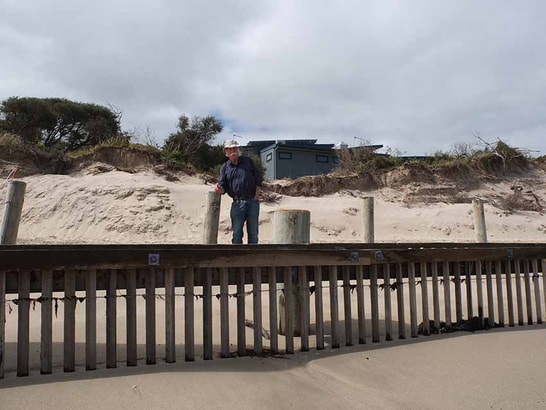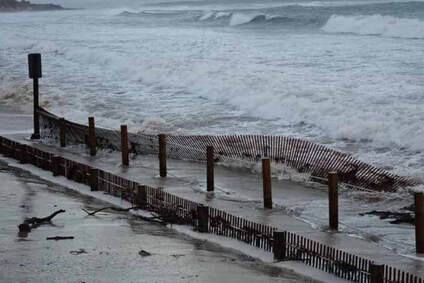 Dave Sutton: Results from a trial protective fence on the Inverloch beach are promising
Dave Sutton: Results from a trial protective fence on the Inverloch beach are promising By Catherine Watson
AMID the gloom surrounding the imperilled Inverloch Surf Life Saving Clubhouse and the Bunurong Coast road, there is a faint glimmer of hope.
Two wet sand fences, installed as a trial, are showing good results, dissipating the force of storm surges and accreting sand behind the fence palings.
One of the fences is in front of the clubhouse and the other about half a kilometre away, where the eroding beach now threatens the coast road.
AMID the gloom surrounding the imperilled Inverloch Surf Life Saving Clubhouse and the Bunurong Coast road, there is a faint glimmer of hope.
Two wet sand fences, installed as a trial, are showing good results, dissipating the force of storm surges and accreting sand behind the fence palings.
One of the fences is in front of the clubhouse and the other about half a kilometre away, where the eroding beach now threatens the coast road.
The South Gippsland Conservation Society (SGSC) is now calling for the fence trial to be extended the length of the beach.
“The fences are protecting the clubhouse and the road,” SGSC vice-president Dave Sutton said. “We’d like to see it extended to protect the vegetation, which is just as valuable.”
“The fences are protecting the clubhouse and the road,” SGSC vice-president Dave Sutton said. “We’d like to see it extended to protect the vegetation, which is just as valuable.”
| He points out that the new Marine and Coastal Act explicitly states that vegetation is as valued as built assets. The fences were installed by the Inverloch Coastal Protection Working Group, a multi-agency group tasked with finding short- and long-term solutions to the unprecedented rate of erosion along the Inverloch beach, around 50 metres in the past few years. | What we don’t want to do is ... turn the wild Victorian coast into walled coastline like we see in some parts of Europe. Anthony Boxshall, chair of the Victorian Marine and Coastal Council |
 The first wet sand fence trial on the Inverloch beach lasted only a few weeks. Photo: Aileen Vening
The first wet sand fence trial on the Inverloch beach lasted only a few weeks. Photo: Aileen Vening Mr Sutton said the first trial sand fences were relatively flimsy constructions that fell apart very quickly. “They learnt from that. These seem to be working much better.”
While the visible top of the fences looks like an ordinary paling fence, about 50 metres in length, the construction is actually much sturdier than it looks, with the piles buried several metres into the sand.
Mr Sutton says sand is gradually accreting behind the middle section of the fences, giving some hope that the rapid erosion can be halted or even reversed.
The conservation group believes they provide the best low-cost short term measure to save the beach.
Erosion isn’t new on the Inverloch beach. The beach has been in a dynamic cycle of erosion and renourishment at least since Europeans have been in the area. What is new is the rapid rate of erosion, due to rising sea levels, higher swells and high tides, and more intense winds and storm surges.
The sand dunes have retreated some 50 metres in the past six years, leaving the life saving clubhouse perched precariously less than eight metres from the edge of the dunes.
A gate to the back of the clubhouse – the beach side – is newly padlocked to stop people taking a short cut to the beach. First, because it’s now dangerous, with a 10-metre drop and second to stop any further unnecessary loss of sand.
As an emergency measure, enormous quantities of sand were dumped in front of the clubhouse during the winter storm season. Most of this has since washed away – as predicted – and more sand was dumped in front of the clubhouse last week after unseasonal storms two weekends ago further eroded the sand cliffs.
The conservation society is also supporting the working group’s plan to place giant geotextile-filled sandbags in front of the clubhouse, although somewhat less enthusiastically.
Mr Sutton said they would prefer to hold off on the proposed installation until the effectiveness of the wet sand fences was evaluated at the end of the summer, but also understood that the sandbags provides more immediate certainty for protecting the clubhouse.
Meanwhile a few determined locals – including a former shire engineer – continue to push for a rock wall in front of the clubhouse.
Mr Sutton was sceptical. “Rock walls have never worked. They just relocate the erosion to the ends of the wall. Jam Jerrup is a good example. How long are you going to make the rock wall? The answer is – once you’ve met up with the other end of it, around Australia. That’s when you’ll succeed.
“If you build a rock wall here, you will have no beach here because it will flatten itself out. It will end up with high tide hard against the rock wall when it comes in, and the low tide won’t be that far away.”
While the visible top of the fences looks like an ordinary paling fence, about 50 metres in length, the construction is actually much sturdier than it looks, with the piles buried several metres into the sand.
Mr Sutton says sand is gradually accreting behind the middle section of the fences, giving some hope that the rapid erosion can be halted or even reversed.
The conservation group believes they provide the best low-cost short term measure to save the beach.
Erosion isn’t new on the Inverloch beach. The beach has been in a dynamic cycle of erosion and renourishment at least since Europeans have been in the area. What is new is the rapid rate of erosion, due to rising sea levels, higher swells and high tides, and more intense winds and storm surges.
The sand dunes have retreated some 50 metres in the past six years, leaving the life saving clubhouse perched precariously less than eight metres from the edge of the dunes.
A gate to the back of the clubhouse – the beach side – is newly padlocked to stop people taking a short cut to the beach. First, because it’s now dangerous, with a 10-metre drop and second to stop any further unnecessary loss of sand.
As an emergency measure, enormous quantities of sand were dumped in front of the clubhouse during the winter storm season. Most of this has since washed away – as predicted – and more sand was dumped in front of the clubhouse last week after unseasonal storms two weekends ago further eroded the sand cliffs.
The conservation society is also supporting the working group’s plan to place giant geotextile-filled sandbags in front of the clubhouse, although somewhat less enthusiastically.
Mr Sutton said they would prefer to hold off on the proposed installation until the effectiveness of the wet sand fences was evaluated at the end of the summer, but also understood that the sandbags provides more immediate certainty for protecting the clubhouse.
Meanwhile a few determined locals – including a former shire engineer – continue to push for a rock wall in front of the clubhouse.
Mr Sutton was sceptical. “Rock walls have never worked. They just relocate the erosion to the ends of the wall. Jam Jerrup is a good example. How long are you going to make the rock wall? The answer is – once you’ve met up with the other end of it, around Australia. That’s when you’ll succeed.
“If you build a rock wall here, you will have no beach here because it will flatten itself out. It will end up with high tide hard against the rock wall when it comes in, and the low tide won’t be that far away.”